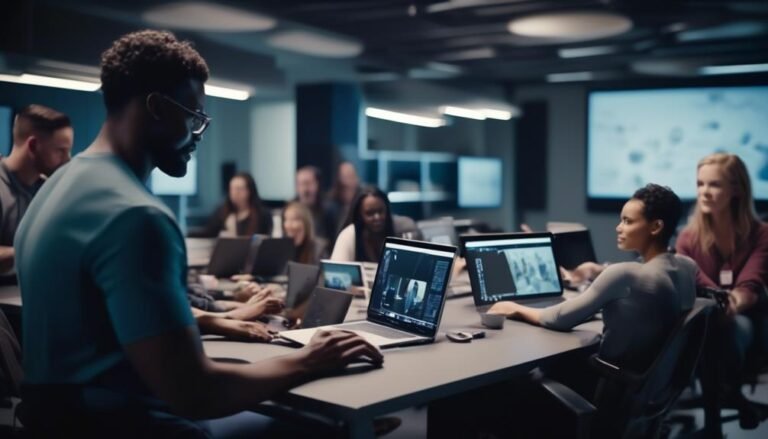Asynchronous Vs. Synchronous Learning: What's Best for Your Team?
In today's ever-evolving work environment, the need for effective team learning methods has become increasingly crucial.
Asynchronous and synchronous learning are two widely discussed approaches that hold distinct advantages and challenges for teams.
The decision of which method to employ can significantly impact a team's productivity, engagement, and overall success.
Understanding the intricacies of each approach and its alignment with the team's dynamics is essential for making an informed choice.
As we delve into the nuances of asynchronous and synchronous learning, we will uncover the factors that can help your team thrive in its pursuit of knowledge and skill development.
Key Takeaways
- Asynchronous learning allows for flexible engagement and self-paced learning, accommodating diverse learning styles and preferences.
- Synchronous learning involves real-time, interactive sessions that foster a sense of community and collaboration, offering immediate feedback and structured learning experiences.
- Asynchronous learning promotes better time management, reduced stress, and empowers learners to access materials at any time, supporting remote collaboration for individuals in different time zones.
- Synchronous learning enables real-time interaction, group discussions, and development of communication and teamwork skills, allowing for immediate feedback and assessment.
Understanding Asynchronous Learning
Understanding asynchronous learning is essential for comprehending the differences between asynchronous and synchronous learning methods. Asynchronous learning allows for flexible engagement, enabling learners to access course materials and participate in discussions at their convenience. This method promotes independent progress, as individuals have the freedom to set their own pace and allocate time for learning based on their schedules.
Unlike synchronous learning, which requires real-time participation, asynchronous learning provides the opportunity for deeper contemplation and reflection before responding to discussions or completing assignments. Learners can engage with course content through various mediums such as pre-recorded lectures, discussion boards, and online resources. This method accommodates a diverse range of learning styles and preferences, catering to individuals who thrive in self-directed environments.
Additionally, asynchronous learning fosters a sense of autonomy, as learners take ownership of their educational journey. By understanding the characteristics of asynchronous learning, institutions and educators can effectively design and deliver courses that cater to the diverse needs of learners, promoting a more inclusive and accessible learning environment.
Exploring Synchronous Learning
Having gained insight into the flexibility and independence of asynchronous learning, it is now imperative to examine the interactive and real-time nature of synchronous learning. Synchronous learning involves real-time, interactive sessions that allow participants to engage with the material and with each other simultaneously. This form of learning offers numerous benefits, including the ability to ask questions and receive immediate feedback, fostering a sense of community and collaboration, and providing a more structured and guided learning experience.
Synchronous engagement allows for dynamic discussions, group activities, and live demonstrations, creating an environment that closely mirrors traditional in-person learning. This can lead to increased engagement and participation, as learners have the opportunity to interact with instructors and peers in a live setting. Additionally, synchronous learning can be particularly effective for topics that require real-time interaction, such as problem-solving, decision-making, and role-playing scenarios.
Furthermore, synchronous learning can help learners stay on track and remain motivated, as they are more accountable for their participation during live sessions. By exploring the interactive and engaging nature of synchronous learning, organizations can determine the most effective approach for their team's learning needs.
Advantages of Asynchronous Learning
Advantages of asynchronous learning offer students the flexibility to schedule their study time around other commitments, providing the freedom to learn at their own pace.
This self-paced approach allows individuals to delve deeper into complex topics, fostering a deeper understanding and retention of the material.
These advantages cater to diverse learning styles and accommodate various life circumstances, making asynchronous learning a valuable option for many.
Flexibility in Scheduling
An undeniable advantage of asynchronous learning is the flexibility it offers in scheduling, allowing students to engage with course materials at their own convenience. This flexibility supports remote collaboration, enabling individuals from different time zones to participate in discussions and group projects without the constraints of real-time interaction.
Moreover, it fosters better time management as learners can organize their study time around work, family, or other commitments, leading to improved productivity and reduced stress. Additionally, the ability to access materials at any time empowers individuals to learn at their own pace, catering to diverse learning styles and preferences.
Ultimately, the flexibility in scheduling provided by asynchronous learning promotes autonomy and self-discipline, contributing to a more effective and personalized learning experience.
Self-Paced Learning Opportunities
The flexibility in scheduling offered by asynchronous learning seamlessly extends to self-paced learning opportunities, providing students with the autonomy to progress through course materials at their preferred speed.
This self-directed approach allows individuals to take control of their learning experience, tailoring it to their specific needs and preferences.
Self-paced learning opportunities enable learners to delve deeper into areas where they need more time for comprehension, while swiftly moving through familiar concepts.
This personalized learning experience fosters a deeper understanding of the material, as individuals can dedicate more time to challenging topics and accelerate through content they grasp quickly.
Ultimately, self-paced learning empowers individuals to take ownership of their educational journey, promoting autonomy, motivation, and a heightened sense of accomplishment.
Benefits of Synchronous Learning
Synchronous learning offers the benefit of real-time interaction, enabling students to actively engage with instructors and peers. This immediate feedback loop allows for clarification of concepts and a deeper understanding of the material.
These advantages contribute to a more dynamic and interactive learning experience for students.
Real-Time Interaction Benefits
Real-time interaction in synchronous learning offers immediate engagement and collaboration opportunities for students and instructors. This real-time engagement fosters a dynamic learning environment, allowing for instant feedback and clarification on complex topics. The ability to ask questions and receive immediate responses enhances understanding and retention of the material.
Additionally, real-time interaction enables students to participate in group discussions, share insights, and work together on projects in a collaborative manner. The live interaction also facilitates the development of communication and teamwork skills, which are essential in professional settings.
Furthermore, synchronous learning allows for real-time assessment and evaluation, enabling instructors to gauge students' comprehension instantly and make necessary adjustments to the lesson plan as needed.
Immediate Feedback Advantages
Immediate feedback in synchronous learning enhances students' understanding and retention of the material, fostering a dynamic and engaging learning environment. Through immediate feedback, instructors can address misconceptions or gaps in learning, allowing students to correct their understanding in real-time. This fosters active participation and encourages learners to stay engaged, as they receive instant validation or redirection. Moreover, immediate feedback allows for the timely implementation of engagement strategies, such as interactive discussions, polls, or quizzes, ensuring that learners are actively involved in the learning process. The table below illustrates some common engagement strategies used in synchronous learning environments.
| Engagement Strategies | Description |
|---|---|
| Interactive Discussions | Real-time exchange of ideas and opinions among students and instructors. |
| Polls | Instant surveys to gauge understanding and opinions on specific topics. |
| Quizzes | Immediate assessments to reinforce learning and measure comprehension. |
| Group Activities | Collaborative tasks designed to promote teamwork and critical thinking. |
Challenges of Asynchronous Learning
An inherent challenge of asynchronous learning is the potential for reduced student engagement and interaction, which can impact the depth of learning and knowledge retention. This mode of learning presents specific challenges that learners and educators need to address effectively. These challenges include:
- Time Management: Asynchronous learning requires strong time management skills from learners. Without the structure of live classes, students must manage their time effectively to complete their coursework and participate in discussions.
- Communication Challenges: In asynchronous learning, communication is often delayed, leading to potential misunderstandings or misinterpretations. This delay can hinder the collaborative aspect of learning and make it challenging for students to receive immediate clarifications.
- Social Isolation: The lack of real-time interaction with peers and instructors can lead to feelings of isolation and disconnection, which can impact motivation and overall learning experience.
Addressing these challenges requires intentional strategies such as providing clear communication channels, promoting active participation, and offering support for time management skills. By acknowledging and actively mitigating these challenges, the effectiveness of asynchronous learning can be significantly improved.
Drawbacks of Synchronous Learning
In the context of synchronous learning, challenges may arise due to the need for simultaneous participation and engagement from all participants. One of the drawbacks of synchronous learning is the limited engagement it offers. Not all participants may feel comfortable or inclined to actively participate in real-time discussions or activities, leading to reduced interaction and collaboration.
Additionally, technological barriers can impede the effectiveness of synchronous learning. Issues such as poor internet connectivity, incompatible devices, or lack of technical proficiency among participants can hinder the smooth delivery and reception of synchronous learning materials. These barriers may result in disruptions, delays, or even exclusion of some participants from fully engaging in the learning process.
Moreover, the rigid time constraints of synchronous learning can be challenging for individuals in different time zones or with conflicting schedules, limiting their ability to participate fully. Addressing these drawbacks requires careful consideration of alternative strategies to maximize engagement and overcome technological barriers, ensuring that all participants can benefit from synchronous learning experiences.
Implementing Asynchronous Learning
Given the challenges and limitations of synchronous learning, implementing asynchronous learning can offer a more flexible and inclusive approach to engaging participants. Asynchronous learning enables organizations to maximize engagement and foster remote collaboration, ultimately leading to more effective skill development and knowledge retention.
Here are three key strategies for successfully implementing asynchronous learning:
- Curate Multimedia Content: Leverage a variety of multimedia resources such as videos, podcasts, and interactive modules to cater to diverse learning preferences and enhance participant engagement.
- Utilize Discussion Forums and Collaboration Tools: Encourage asynchronous discussions and group collaboration through platforms like forums, chat rooms, and project management tools. This enables participants to engage in meaningful interactions regardless of their geographical locations and time zones.
- Offer Self-Paced Learning Paths: Provide participants with the flexibility to access learning materials at their convenience, allowing them to progress through the content at their own pace while balancing work and personal commitments.
Adopting Synchronous Learning Techniques
To enhance real-time engagement and interaction in the learning process, organizations can adopt synchronous learning techniques that facilitate immediate communication and collaboration among participants. Synchronous learning involves real-time interaction between instructors and learners, often through video conferencing, live chat, or live-streamed lectures. This approach allows for virtual engagement that mimics the dynamics of traditional in-person classrooms, enabling participants to ask questions, receive instant feedback, and engage in interactive activities.
| Synchronous Learning Techniques | Description | Benefits | Considerations |
|---|---|---|---|
| Video Conferencing | Utilizes live video and audio to connect instructors and learners in real-time | – Enables face-to-face interaction<br>- Facilitates immediate feedback<br>- Fosters a sense of community | – Requires stable internet connection<br>- Time zone differences may pose scheduling challenges |
| Live Chat | Allows participants to engage in real-time text-based communication during learning sessions | – Encourages active participation<br>- Enables quick exchange of ideas and questions<br>- Supports group discussions | – May require moderation to manage discussions effectively |
| Live-Streamed Lectures | Involves real-time broadcasting of lectures or presentations with interactive elements | – Enhances accessibility to educational content<br>- Allows for immediate clarification of complex topics<br>- Promotes learner engagement | – Technical issues such as buffering or audio/video quality can disrupt the learning experience<br>- Limited opportunity for personalized attention |
Conclusion
In conclusion, when considering the best approach for team learning, it is essential to weigh the benefits and drawbacks of asynchronous and synchronous learning.
Both methods offer unique advantages and challenges, but the most effective approach will depend on the specific needs and goals of the team.
Ultimately, the question remains: which learning method will best support the team's objectives and foster a successful learning environment?







